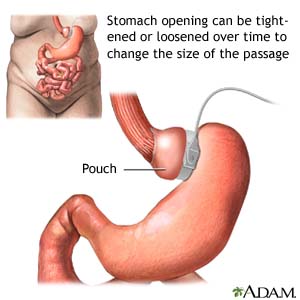The originating document has been archived. We cannot confirm the completeness, accuracy, or currency of the content.
Adjustable Gastric Banding
Medically reviewed by Drugs.com. Last updated on Feb 21, 2024.
What is gastric banding?
Gastric banding is a type of weight loss surgery. During surgery, healthcare providers put a soft band around the top part of your stomach. This divides the stomach into one small pouch and one large pouch. When you eat, food collects in the small pouch. Because the pouch is very small, you will feel full quickly. There is a small opening in the smaller pouch that allows food to pass into the larger pouch. Between meals, the food moves slowly into the larger pouch and is digested normally. Over time, you may lose weight because you feel full sooner and cannot eat as much food during a meal. Your healthcare provider can tighten or loosen the band as needed after the surgery.
How is a gastric band put around my stomach?
Gastric banding is usually done during laparoscopic surgery. During surgery, small incisions are made in your stomach. A laparoscope and other instruments are put through the incisions. A laparoscope is a tube with a camera on the end. Healthcare providers use the instruments to place the gastric band around your stomach. Gastric banding may also be done during a procedure called a laparotomy. During a laparotomy, one large incision is made in your stomach. Healthcare providers put the gastric band on your stomach through this incision.
 |
When will I begin to lose weight?
As you begin to eat differently, you will begin to lose weight. The amount of weight you lose, and the speed at which you lose it, depends on certain things. These include how well you follow your diet and exercise plans, how healthy you are, and how much you weighed before surgery. It may take 18 to 24 months to reach a healthy weight.
What are the risks of gastric banding?
- During surgery, you may bleed too much or get an infection. The gastric band may slip out of place, break, or leak. The band may scar or erode the stomach tissue. You may need a larger incision than expected during laparoscopic surgery. After surgery, you may lose weight and then gain it back. You may not lose any weight.
- If you often eat too much and do not follow instructions, you may stretch out your stomach pouch. If you eat too much, too fast, or do not chew well enough before you swallow, you may vomit. You may have abdominal pain, heartburn, or a stomach ulcer. Food that is not chewed well enough may get stuck in the opening between the small and large stomach pouches.
Care Agreement
You have the right to help plan your care. Learn about your health condition and how it may be treated. Discuss treatment options with your caregivers to decide what care you want to receive. You always have the right to refuse treatment. The above information is an educational aid only. It is not intended as medical advice for individual conditions or treatments. Talk to your doctor, nurse or pharmacist before following any medical regimen to see if it is safe and effective for you.Further information
Always consult your healthcare provider to ensure the information displayed on this page applies to your personal circumstances.
